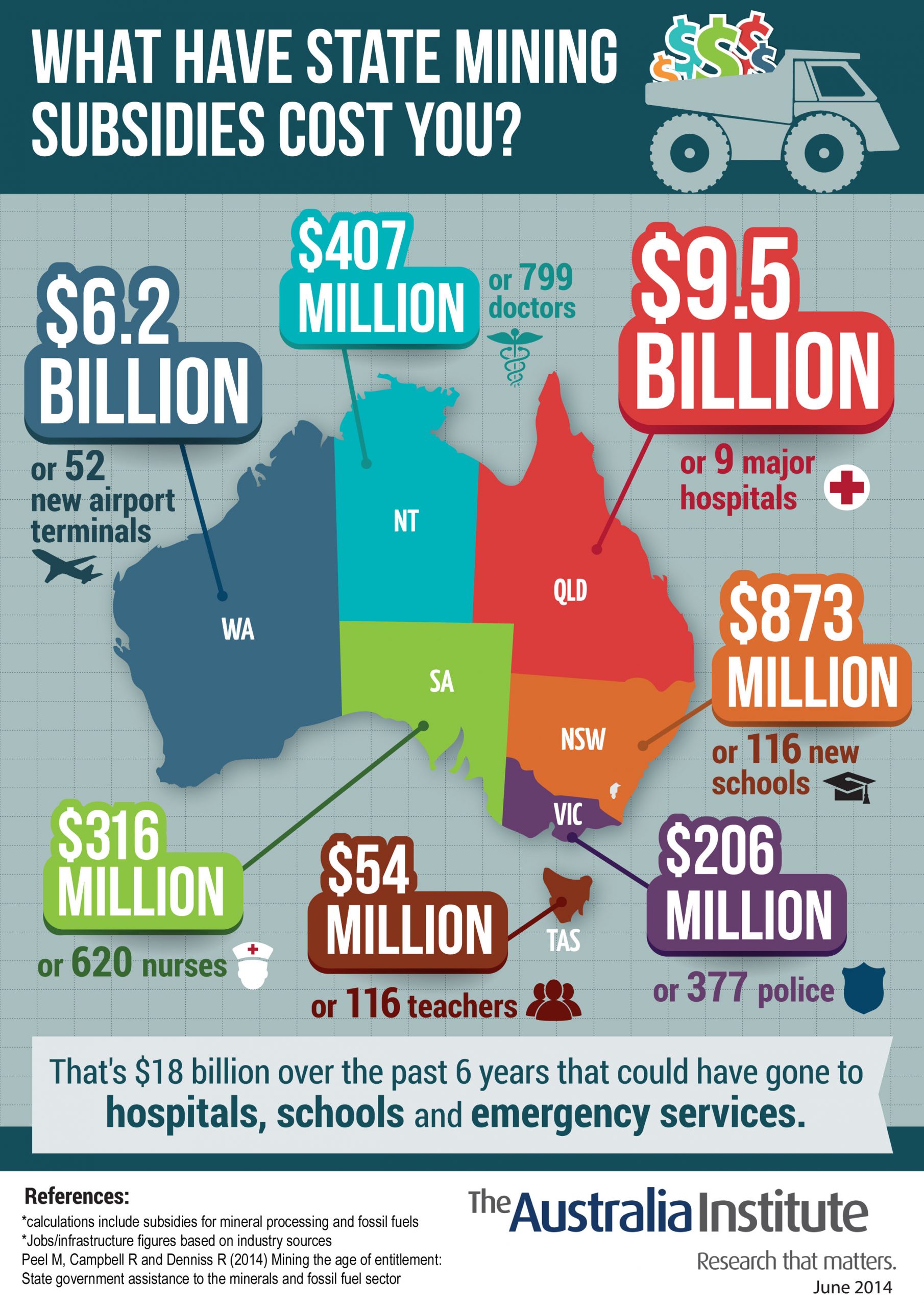Digging deep for equity
- Mining the Age of Entitlement
- Childcare costs increase
- Frightbats for equity
- Temporary reprieve for welfare recipients
- Infographic
Mining the Age of Entitlement
Money you’ve spent on one thing is money you can’t spend on another.
Money the States pay to mining companies is money they can’t invest in essential services, infrastructure, and other things you would expect the States to be using taxpayers’ money for.
TAI released a paper this week that, for the first time, put a dollar figure on the money flowing to big mining through subsidies, dodged taxes and investment in infrastructure.
We did ask for input from all state based Minerals Councils and APPEA, though none was forthcoming. Instead we scoured the budget papers from 2008-08 to 2013-14 of all the States to determine the extent of State government support to the mining industry.
The results were startling.
Queensland, which gained so much attention with its cut backs to health, has spent $9.5 billion over six years. That’s enough for nine major new hospitals.
Queensland Nurses Union secretary Beth Mohle got it right when she said “The health system has suffered because the priorities of government are all wrong… surely the priorities must be in terms of essential service provision, and not in largesse to big business.”
In 2013-14 Queensland plans to spend $1.5 billion on industry assistance, which is almost 60 per cent of what it will receive in royalties.
In Western Australia, $6.2 billion was provided over the same time. That could have ended their airport woes for good, with that amount equivalent to 52 new airport terminals.
New South Wales which has recently handed down its budget, pledging money to “child protection, homelessness and disability services”. The $872 million that went to big mining over the past six years could have provided 116 new schools.
In the Northern Territory 799 doctors could be working for the $407 million given up in subsidies, and South Australia would have 620 additional nurses if not for the $316 million that flowed to the mining industry.
377 police could have been employed in Victoria at $206 million, and Tasmania could have employed 116 teachers for the $54 million that went to subsidising the mining industry.
There has been no transparency in the spending that supports an already profitable industry, or in the many other ways financial assistance is provided to these largely foreign-owned companies. It is clear through our research that Australia doesn’t profit to anywhere near the extent we had previously thought from the mining industry.
Read our report: Mining the Age of Entitlement
Childcare costs increase
The National Centre for Social and Economic Modelling (NATSEM) has released a report on childcare affordability this week. The timing of the release comes after the government budget in May and ahead of the July release of the Productivity Commission’s draft report on childcare.
In May the government said it would freeze the income eligibility threshold for the Child Care Benefit. But opposition parties have said they will turn up the heat on the proposal.
Since before the 2013 Federal election and up until the May budget announcement, the Abbott government had relinquished any leadership on childcare by outsourcing it to the Productivity Commission (PC). The Australia Institute has made a submission to the PC inquiry documenting the increasing affordability difficulties reported by Australian families in the decade from 2001.
The NATSEM report finds that along with increased use of childcare services, the cost is also increasing. This increase has been consistently higher than increases in the consumer price index (CPI) and average household incomes. Little wonder then that Australians have reported cost difficulties.
The report does, however, show that increased funding of childcare has offset the cost to households. While increased funding reduces the cost of childcare to families, it has not stopped cost increases over time. Successive governments have been caught in a game of catch-up with an industry which responds to increased funding with price increases.
In Trouble with childcare The Australia Institute argued that the policy problem lies in the government’s surrender of childcare to the free-market. This surrender leaves cash as the only mechanism for addressing cost difficulties for families. A more involved role for government in the childcare sector would provide greater opportunity to manage rocketing childcare costs.
Frightbats for equity
Sue Boyce, in her Valedictory speech to the Senate highlighted an issue that reaches farther than the confines of Parliament House, but is a good indicator of our community more generally.
Women make up half of the Australian population. As Ms Boyce pointed out, there are now no female Senators from the LNP, and only one woman, Julie Bishop, in the Abbott Cabinet. Women make up only 22 per cent of parliamentarians, and five per cent of Cabinet.
Currently women make up only 36 per cent of manager positions, and 9% of ASX500 Director positions. This has nothing at all to do with merit, but is a big reason for the increasing economic inequality that women face as they age.
Lower incomes and time out of work for caring duties, which fall most heavily to women (in our society at least) mean women are far less able to accrue the same amount of super as someone who has moved more easily into management positions and spent little time out of work.
The ‘gender pay gap’, where women earn on average 17.4 per cent less than men, along with time out for caring, means the average women will earn $1.4 million less over their lifetime than the average man.
Gender-reporting by business was not wound back to the extent originally slated by the Abbott government early this year, however will still be weaker than it is now. It was pressure from women’s groups that ensured it wasn’t weakened further.
Better political representation of women would go some way to address these issues, however even pre-selection for positions has been historically difficult. Until we can achieve the equal representation that will address entrenched inequities, it seems the ‘frightbats’ still have a way to go.
Temporary reprieve for welfare recipients
There has been a temporary reprieve to the welfare cuts the government wielded in the May budget due to the Senate review process. Australians will not yet need to pay an extra $7 to see the doctor, have a blood test or x-ray. Not yet will people aged under 30 have to meet required activity tests for receiving the Newstart Allowance without receiving any support for six months (or perhaps longer). Not yet will low-income families have to worry about the financial impacts of their youngest child turning six.
How long the reprieve lasts will be determined by the new Senate, that will sit for the first time on 7 July 2014. A raft of new laws will confront the new and returning Senators. Amongst them will be a range of changes to welfare support in Australia.
Some of these changes are to indexation of payments and eligibility criteria. For example the eligibility cut-off for many payments (including Newstart, Child Care Benefit and Widow and Sickness allowances) were to be frozen for three years from next week.
As inflation increases the cost of living and wage rates respond, people may have found that they are no longer eligible for support they’ve relied on. This means that a reduction or cessation in support would coincide with increased living costs.
The same decline in the real value of payments awaits pensioners but the effect will take a little longer to bite. If passed by the Senate the pension payment will be tied to inflation, and will no longer be indexed to – generally higher- average earnings. Pensioners will potentially join Newstart recipients in receiving a declining level of financial support compared with those who are employed.
These cuts to support for many Australians who rely on financial support due to their circumstances depend on the votes of the Senate.
The Coalition will presumably support the budget, despite welfare cuts hurting many in their own electorates. The Greens have been reviewing proposed cuts at Committee, and Labor commissioned modelling to measure the extent of the cuts. The final say will more than likely fall to independent Senators and elected members of the Palmer United Party. How long will the reprieve be?
Infographic

Between the Lines Newsletter
The biggest stories and the best analysis from the team at the Australia Institute, delivered to your inbox every fortnight.
You might also like
Have your say in the EPBC Act review of salmon farming in Macquarie Harbour
The Australia Institute Tasmania’s work was critical to triggering the federal EPBC review of salmon farming in Macquarie Harbour.
Nordic Talks: A plus or F minus? Educational Equity in Finland and Australia [Webinar]
More than a decade after the Gonski review into Australia’s school funding aimed to reduce the impact of social disadvantage on educational outcomes, educational outcomes for Australian schoolchildren are getting worse. The success of Finnish educational outcomes shows that equity drives excellence for all students. This is one of a five-part special series of Follow
Eating the three-eyed fish: where is Australia on nuclear wastewater in the Pacific?
The Australian government’s muted response to Japan’s release of Fukushima wastewater into the Pacific raises serious questions about its commitment to the region and Australia’s history of standing against nuclear testing.


